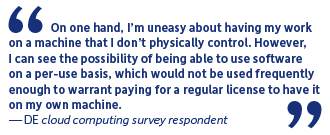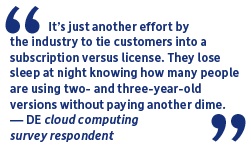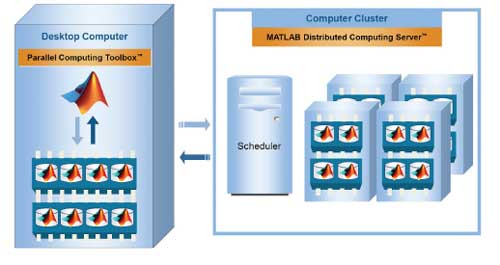Latest News
June 1, 2011
By Pamela J. Waterman
Trying to get a handle on cloud-based engineering analysis can be like trying to get a fistful of a real cloud. The edges are undefined, the shape keeps changing, and it’s hard to see what’s right in front of you. Current software-vendor opinions and solutions range from not addressing the topic to “working on it” to fully supporting multiple levels of cloud-based services based on more than a year’s experience.
 Velocity and pressure values of a formation flight of Pusher UAVs demonstrating the complexity of analysis well suited for computation on a cloud-based system. Analysis performed with CD-adapco’s STAR-CCM+ Power-on-Demand cloud-computing services. Image courtesy CD-adapco. |
DE spoke to five major vendors deeply involved in finite element analysis (FEA) and computational fluid dynamics (CFD) to view cloud-based analyses in action.
Approaches to Cloud Computing
In 2008, CD-adapco took the first steps toward expanding user resources for its STAR-CCM+ CFD software by creating Power Session, a pricing structure that gave users access to unlimited computation resources (as many cores as desired) for a single fixed fee.
The approach’s success led to user requests for multiple simultaneous sessions for such projects as design-of-experiments. As a result, in March 2010, CD-adapco introduced a new product-license plan that incorporates cloud-computing, called STAR-CCM+ Power-on-Demand. This option allows users to run a STAR-CCM+ Power Session simulation using any on-demand service among public, private or hybrid clouds, and fills two purposes.
“First, the user has access to the software by the hour,” says Jean-Claude Ercolanelli, CD-adapco’s senior vice president of product management. “We don’t count the number of processors that are running or the number of sessions running at the same time. We’re giving him access to perform a large number of runs at the same time on an unlimited number of cores, for very quick turnaround time.” Either CD-adapco or the user can upload the software to the cloud.
 Power-on-Demand fills a second need, too. “It often happens you have the need for a ‘burst’ capacity—maybe something for a new project where you need answers as quickly as possible,” Ercolanelli explains. “Because this is usage by the hour, it falls into another budget (than regular licenses). A project budget can be used to just run it for the time needed, and be very flexible, very effective.” Time-use data is sent to the customer.
Power-on-Demand fills a second need, too. “It often happens you have the need for a ‘burst’ capacity—maybe something for a new project where you need answers as quickly as possible,” Ercolanelli explains. “Because this is usage by the hour, it falls into another budget (than regular licenses). A project budget can be used to just run it for the time needed, and be very flexible, very effective.” Time-use data is sent to the customer.
Users may still want a local license for CAD import, model preparation and other interactive steps. Interestingly, although cloud power is better suited for pure number crunching, some users employ Power-on-Demand for all their work.
SIMULIA is taking a community approach to building its cloud services. The company believes the ability to flexibly use common resources across a functional group—in a department, organization or supply chain—should be the overall goal, and using a cloud-based system is just one element to achieving it.
A community-style platform, whether open to an industry or private for a specific project, lets users in both the modeling and simulation worlds readily communicate information that describes models, results and possible scenarios. Parent company Dassault Systemes has hundreds of such communities in a mix of public and private versions.
Finding an efficient community concept to manage, manipulate, understand and visualize data may indeed involve a cloud-based system, although today’s general-purpose (GP) clouds are not yet optimized for high-performance computing (HPC). However, SIMULIA officials believe the currently limiting issues of compute speed and data transfer are not inherent in the cloud concept and will be overcome, so the company is beta-testing a cloud-based version. Most likely, the configuration will have dedicated HPC clouds connected to GP clouds, with a collaborative, managed environment invisible to the user.
 Autodesk has made efforts across its entire platform of design, visualization and simulation products to branch off into both software-as-a-service (SaaS) and cloud computing, or as the company often says, infinite computing. Autodesk’s simulation portfolio, which includes Autodesk Inventor Professional, Autodesk Simulation, CFdesign and Autodesk Moldflow, already takes advantage of some level of cloud operation.
Autodesk has made efforts across its entire platform of design, visualization and simulation products to branch off into both software-as-a-service (SaaS) and cloud computing, or as the company often says, infinite computing. Autodesk’s simulation portfolio, which includes Autodesk Inventor Professional, Autodesk Simulation, CFdesign and Autodesk Moldflow, already takes advantage of some level of cloud operation.
“If you think about the history of simulation in general, this is really the next logical step,” says Bob Williams Autodesk product marketing manager for simulation. “Simulation providers have done different things to continually keep up with what’s available with hardware, such as supporting increasing RAM and distributed computing, making a very direct connection between hardware and simulation software. Yet those resources are still limited by the hardware a company has. If you take the same concept and move it to the cloud, it removes all those barriers.”
Autodesk Moldflow software includes a feature called Design of Experiments that previously wasn’t extensively used, but is now popular on the cloud. Williams points out that in the past, you simply lived with your power limitations; now, users can create more realistic simulations with fewer simplifications.
 Analysis of air as it flows around and interacts with two NASCAR race cars in action, demonstrating the complexity of computations well suited for computation on a cloud-based system. Analysis performed with CD-adapco’s STAR-CCM+ Power-on-Demand cloud-computing services. Image courtesy CD-adapco. |
Autodesk Moldflow use on the cloud has been by invitation to customers and for no extra fee. Inventor Optimization technology was wide open to Inventor users for about a year, also for free, and hundreds of users have performed thousands of simulations on the cloud. Autodesk is working to find an appropriate cost structure for the future, perhaps with monthly licensing. At the same time, the company has no intention of eliminating its desktop software products.
ANSYS officials believe that the primary technical issues in using centralized HPC systems or cloud resources are related to remote access. Simulation files are large, so moving them from user to server and back again is clumsy and time-consuming. One solution is to let customers store the data in an HPC resource while maintaining control over access and intellectual property (IP) protection. Centralized fail-proof licensing, job scheduling and workload prioritization, however, are still viewed as challenges.
For hosted clouds, the company offers a “bring your own license” approach, letting ANSYS customers use licenses they already own, or additional peak-capacity licenses, on any physical system. The new parallel licensing model enables a simulation to execute on thousands of cores without a per-core license.
Moving to a fully public cloud raises additional customer questions about technical, licensing, security and IP challenges. ANSYS is currently in a prototyping phase, testing and benchmarking the overall user experience to understand the technical barriers to adoption.
Toolbox Math in the Cloud
A different angle to this topic comes from MathWorks, the MATLAB people. Users can already scale up their work across local desktop processing cores with MATLAB’s Parallel Computing Toolbox. High-level constructs let users parallelize MATLAB applications without requiring message-processing interface programming. The Toolbox provides eight “workers” (MATLAB computational engines) to execute applications locally on a multi-core desktop.
Without changing the code, users can run the same application on a computing cluster or a grid-computing service, using MATLAB Distributed Computing Server (MDCS) software. A single user license can run on any cluster as long as users have paid for the given number of workers. Perpetual licenses are standard—a real bonus.
 |Diagram showing how MathWorks MATLAB parallel computing workflow that lets users perform scalable, cost-effective analyses using MATLAB workers on a computer cluster. Users develop parallel MATLAB applications using MathWorks Parallel Computing Toolbox on their desktop computers and scale them to a computer cluster running MATLAB Distributed Computing Server software. Image courtesy MathWorks. |
Expanding on this approach, users can take their own MDCS and put it on their preferred cloud structure. Silvina Grad-Freilich, MathWorks’ manager of parallel-computing marketing, says that thousands of MATLAB customers have already downloaded the company’s online white paper titled “Parallel Computing with MATLAB on Amazon Elastic Compute Cloud.” She notes that because security is a big issue, users might want to read Amazon’s own paper on the subject. MathWorks is also piloting a pay-per-hour licensing utility model.
What’s the Real Benefit “Historically, because of the time and hardware resources involved, companies were lucky if they did one or two iterations on a part or design,” he continues. “If we can remove that barrier and let users study many, many iterations, then we can truly start leveraging the concept of using simulation to optimize designs.” |
Cloud Status Report
What issues are still not clear through the mist? One area that has held back simulation on the cloud is the difficulty in analyzing all the data afterward. Today’s users generally must download very large files for post-processing and interactive visualization. However, SIMULIA officials believe that new technologies for rapid remote visualization and smart searches will emerge. These innovations will be key to helping users manage and manipulate the increasing amounts of data generated from ever more scenarios.
Security is another hot topic. The typical agreement between the user and the cloud server (rather than the analysis software vendor) makes many people uncomfortable.
Others disagree, pointing, for example, to Amazon’s years of experience with the task. SIMULIA’s experts have even talked to customers who look to cloud storage as a way to control data, avoiding theft and loss of data from mobile devices and laptops.
Operating in the cloud offers the benefits of scaling and accommodating company growth, saving compute and IT costs for per-seat software upgrades—and even saving on electricity and cooling systems for in-house HPC servers. In fact, CD-adapco notes that many customers, particularly new ones, are choosing them simply because of these cloud-based service advantages. Private. Hosted. Public. And you thought the three cloud types were cirrus, stratus and cumulus. We’re all learning. Stay tuned to the DE weather report for the latest updates on cloud computing.
More Info
Subscribe to our FREE magazine, FREE email newsletters or both!
Latest News
About the Author
Pamela Waterman worked as Digital Engineering’s contributing editor for two decades. Contact her via .(JavaScript must be enabled to view this email address).
Follow DE





